airbag FIAT PUNTO 2020 Owner handbook (in English)
[x] Cancel search | Manufacturer: FIAT, Model Year: 2020, Model line: PUNTO, Model: FIAT PUNTO 2020Pages: 219, PDF Size: 9.82 MB
Page 9 of 219
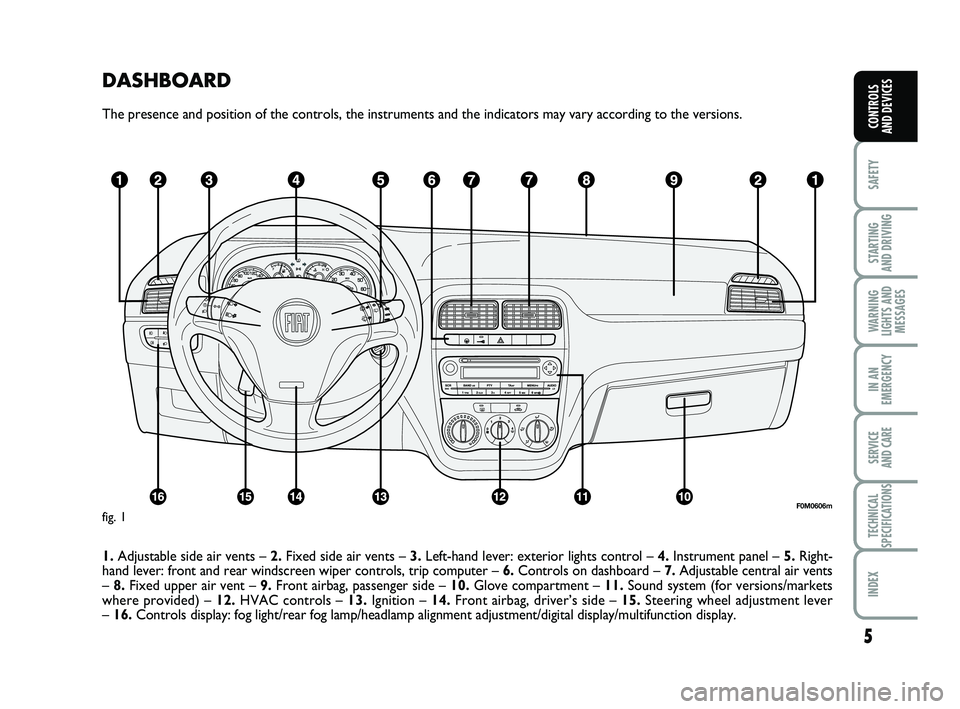
DASHBOARD
The presence and position of the controls, the instruments and the indic\
ators may vary according to the versions.
1.Adjustable side air vents – 2.Fixed side air vents – 3.Left-hand lever: exterior lights control – 4. Instrument panel – 5.Right-
hand lever: front and rear windscreen wiper controls, trip computer –\
6. Controls on dashboard – 7.Adjustable central air vents
– 8. Fixed upper air vent – 9.Front airbag, passenger side – 10. Glove compartment – 11.Sound system (for versions/markets
where provided) – 12. HVAC controls – 13.Ignition – 14.Front airbag, driver’s side – 15. Steering wheel adjustment lever
– 16. Controls display: fog light/rear fog lamp/headlamp alignment adjustment/\
digital display/multifunction display.
5
SAFETY
STARTING
AND DRIVING
WARNING
LIGHTS AND MESSAGES
IN AN
EMERGENCY
SERVICE
AND CARE
TECHNICAL
SPECIFICATIONS
INDEX
CONTROLS
AND DEVICES
F0M0606mfig. 1
001-032 PUNTO POP 1ed EN 31/03/14 09:02 Pagina 5
Page 24 of 219
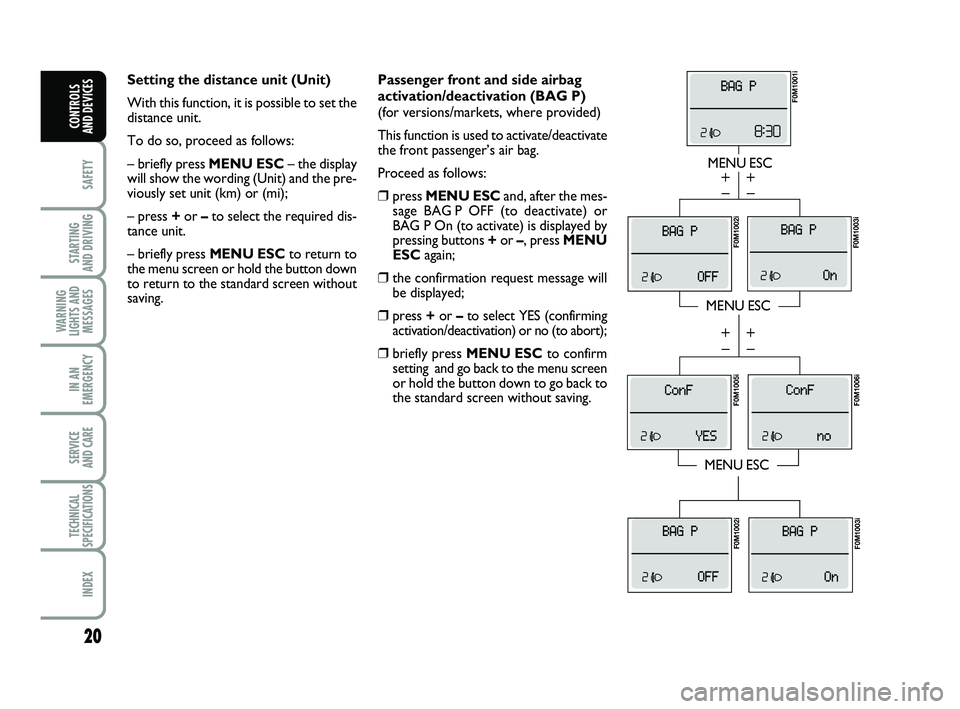
20
SAFETY
STARTING
AND DRIVING
WARNING
LIGHTS AND MESSAGES
IN AN
EMERGENCY
SERVICE
AND CARE
TECHNICAL
SPECIFICATIONS
INDEX
CONTROLS
AND DEVICES
Passenger front and side airbag
activation/deactivation (BAG P)
(for versions/markets, where provided)
This function is used to activate/deactivate
the front passenger’s air bag.
Proceed as follows:
❒press MENU ESC and, after the mes-
sage BAG P OFF (to deactivate) or
BAG P On (to activate) is displayed by
pressing buttons +or –, press MENU
ESC again;
❒the confirmation request message will
be displayed;
❒press +or –to select YES (confirming
activation/deactivation) or no (to abort);
❒briefly press MENU ESC to confirm
setting and go back to the menu screen
or hold the button down to go back to
the standard screen without saving.
MENU ESC
MENU ESC
MENU ESC
–
+
–
+
–
+
–
+
F0M1001i
F0M1003i F0M1002i
F0M1005i
F0M1006i
F0M1002i
F0M1003i
Setting the distance unit (Unit)
With this function, it is possible to set the
distance unit.
To do so, proceed as follows:
– briefly press MENU ESC – the display
will show the wording (Unit) and the pre-
viously set unit (km) or (mi);
– press + or –to select the required dis-
tance unit.
– briefly press MENU ESC to return to
the menu screen or hold the button down
to return to the standard screen without
saving.
001-032 PUNTO POP 1ed EN 31/03/14 09:03 Pagina 20
Page 27 of 219
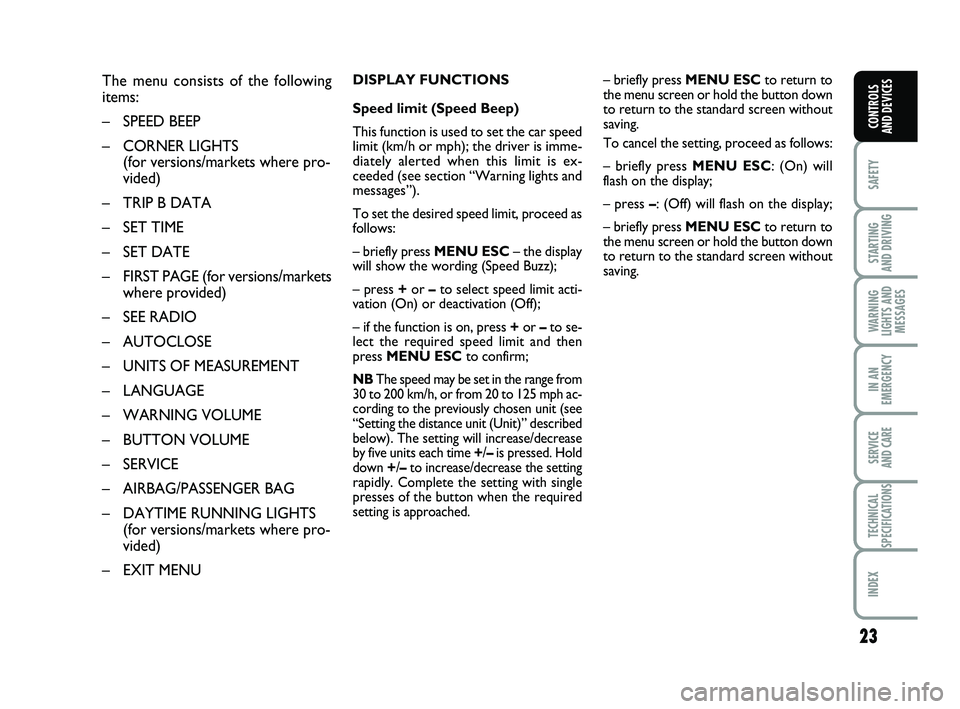
23
SAFETY
STARTING
AND DRIVING
WARNING
LIGHTS AND MESSAGES
IN AN
EMERGENCY
SERVICE
AND CARE
TECHNICAL
SPECIFICATIONS
INDEX
CONTROLS
AND DEVICES
The menu consists of the following
items:
– SPEED BEEP
– CORNER LIGHTS (for versions/markets where pro-
vided)
– TRIP B DATA
– SET TIME
– SET DATE
– FIRST PAGE (for versions/markets where provided)
– SEE RADIO
– AUTOCLOSE
– UNITS OF MEASUREMENT
– LANGUAGE
– WARNING VOLUME
– BUTTON VOLUME
– SERVICE
– AIRBAG/PASSENGER BAG
– DAYTIME RUNNING LIGHTS (for versions/markets where pro-
vided)
– EXIT MENU– briefly press MENU ESC to return to
the menu screen or hold the button down
to return to the standard screen without
saving.
To cancel the setting, proceed as follows:
– briefly press MENU ESC: (On) will
flash on the display;
– press – : (Off) will flash on the display;
– briefly press MENU ESC to return to
the menu screen or hold the button down
to return to the standard screen without
saving.
DISPLAY FUNCTIONS
Speed limit (Speed Beep)
This function is used to set the car speed
limit (km/h or mph); the driver is imme-
diately alerted when this limit is ex-
ceeded (see section “Warning lights and
messages”).
To set the desired speed limit, proceed as
follows:
– briefly press MENU ESC
– the display
will show the wording (Speed Buzz);
– press + or –to select speed limit acti-
vation (On) or deactivation (Off);
– if the function is on, press + or –to se-
lect the required speed limit and then
press MENU ESC to confirm;
NBThe speed may be set in the range from
30 to 200 km/h, or from 20 to 125 mph ac-
cording to the previously chosen unit (see
“Setting the distance unit (Unit)” described
below). The setting will increase/decrease
by five units each time + /– is pressed. Hold
down +/– to increase/decrease the setting
rapidly. Complete the setting with single
presses of the button when the required
setting is approached.
001-032 PUNTO POP 1ed EN 31/03/14 09:03 Pagina 23
Page 33 of 219
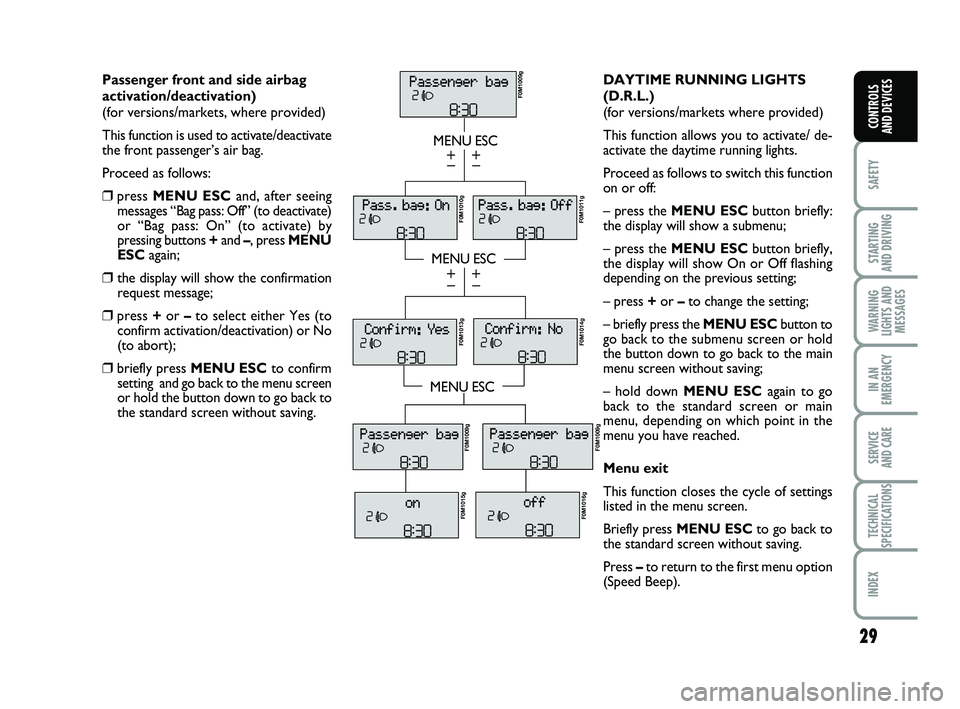
29
SAFETY
STARTING
AND DRIVING
WARNING
LIGHTS AND MESSAGES
IN AN
EMERGENCY
SERVICE
AND CARE
TECHNICAL
SPECIFICATIONS
INDEX
CONTROLS
AND DEVICES
Passenger front and side airbag
activation/deactivation)
(for versions/markets, where provided)
This function is used to activate/deactivate
the front passenger’s air bag.
Proceed as follows:
❒press MENU ESC and, after seeing
messages “Bag pass: Off” (to deactivate)
or “Bag pass: On” (to activate) by
pressing buttons +and –, press MENU
ESC again;
❒the display will show the confirmation
request message;
❒press +or –to select either Yes (to
confirm activation/deactivation) or No
(to abort);
❒briefly press MENU ESC to confirm
setting and go back to the menu screen
or hold the button down to go back to
the standard screen without saving.
MENU ESC
MENU ESC
MENU ESC
–
+
–
+
–
+
–
+
F0M1009g
F0M1011g F0M1010g
F0M1013g
F0M1014g
F0M1009g
F0M1015g
F0M1016g F0M1009g
DAYTIME RUNNING LIGHTS
(D.R.L.)
(for versions/markets where provided)
This function allows you to activate/ de-
activate the daytime running lights.
Proceed as follows to switch this function
on or off:
– press the MENU ESC
button briefly:
the display will show a submenu;
– press the MENU ESC button briefly,
the display will show On or Off flashing
depending on the previous setting;
– press + or –to change the setting;
– briefly press the MENU ESC button to
go back to the submenu screen or hold
the button down to go back to the main
menu screen without saving;
– hold down MENU ESC again to go
back to the standard screen or main
menu, depending on which point in the
menu you have reached.
Menu exit
This function closes the cycle of settings
listed in the menu screen.
Briefly press MENU ESC to go back to
the standard screen without saving.
Press –to return to the first menu option
(Speed Beep).
001-032 PUNTO POP 1ed EN 31/03/14 09:03 Pagina 29
Page 95 of 219
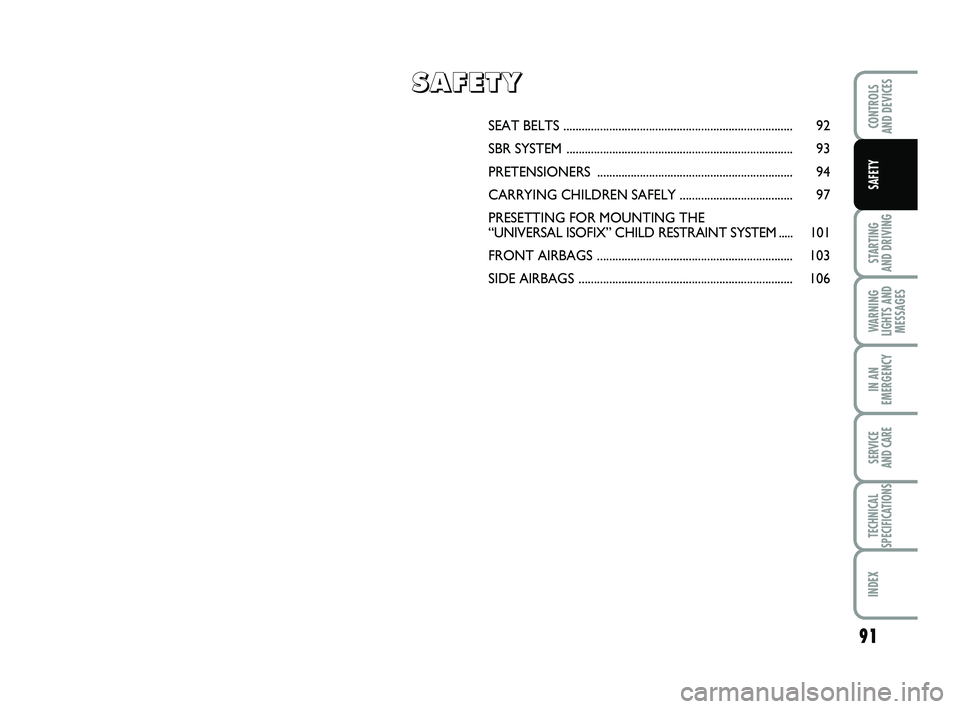
91
STARTING
AND DRIVING
WARNING
LIGHTS AND MESSAGES
IN AN
EMERGENCY
SERVICE
AND CARE
TECHNICAL
SPECIFICATIONS
INDEX
CONTROLS
AND DEVICES
SAFETY
SEAT BEL TS .......................................................................\
.... 92
SBR SYSTEM ......................................................................\
.... 93
PRETENSIONERS ................................................................ 94
CARRYING CHILDREN SAFELY ..................................... 97
PRESETTING FOR MOUNTING THE
“UNIVERSAL ISOFIX” CHILD RESTRAINT SYSTEM ..... 101
FRONT AIRBAGS ................................................................ 103
SIDE AIRBAGS ...................................................................... 106
S
S
A
A
F
F
E
E
T
T
Y
Y
091-110 PUNTO POP 1ed EN 27/03/14 12:02 Pagina 91
Page 102 of 219
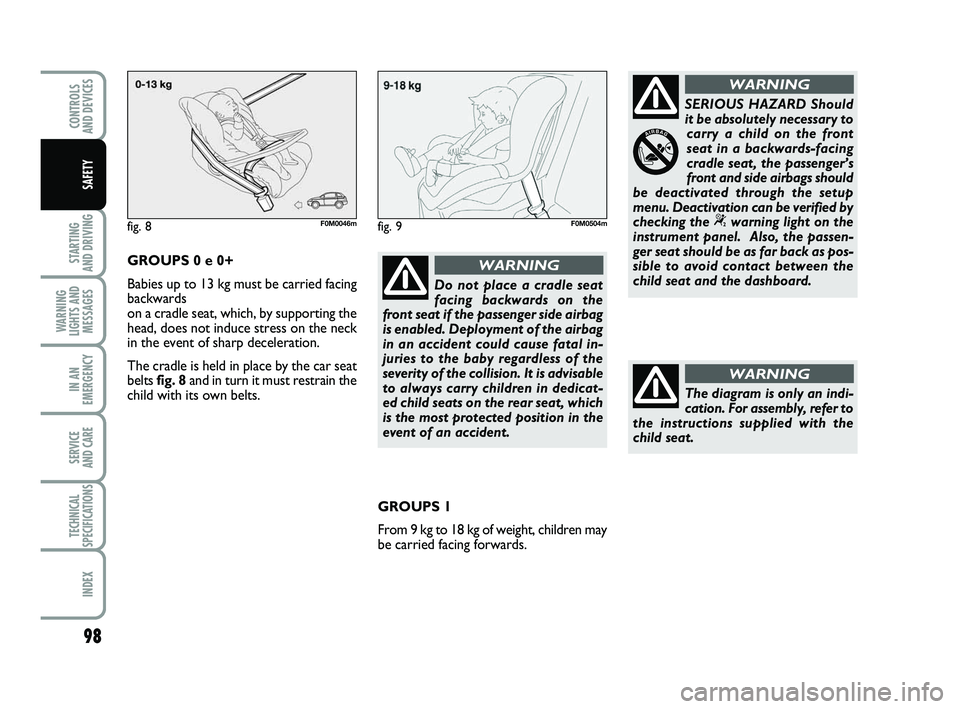
98
STARTING
AND DRIVING
WARNING
LIGHTS AND MESSAGES
IN AN
EMERGENCY
SERVICE
AND CARE
TECHNICAL
SPECIFICATIONS
INDEX
CONTROLS
AND DEVICES
SAFETY
Do not place a cradle seat
facing backwards on the
front seat if the passenger side airbag
is enabled. Deployment of the airbag
in an accident could cause fatal in-
juries to the baby regardless of the
severity of the collision. It is advisable
to always carry children in dedicat-
ed child seats on the rear seat, which
is the most protected position in the
event of an accident.
WARNING
SERIOUS HAZARD Should
it be absolutely necessary to carry a child on the front
seat in a backwards-facing
cradle seat, the passenger’s
front and side airbags should
be deactivated through the setup
menu. Deactivation can be verified by
checking the
“warning light on the
instrument panel. Also, the passen-
ger seat should be as far back as pos-
sible to avoid contact between the
child seat and the dashboard.
WARNING
fig. 8F0M0046mfig. 9F0M0504m
The diagram is only an indi-
cation. For assembly, refer to
the instructions supplied with the
child seat.
WARNING
GROUPS 0 e 0+
Babies up to 13 kg must be carried facing
backwards
on a cradle seat, which, by supporting the
head, does not induce stress on the neck
in the event of sharp deceleration.
The cradle is held in place by the car seat
belts fig. 8 and in turn it must restrain the
child with its own belts.
GROUPS 1
From 9 kg to 18 kg of weight, children may
be carried facing forwards.
091-110 PUNTO POP 1ed EN 27/03/14 12:02 Pagina 98
Page 104 of 219
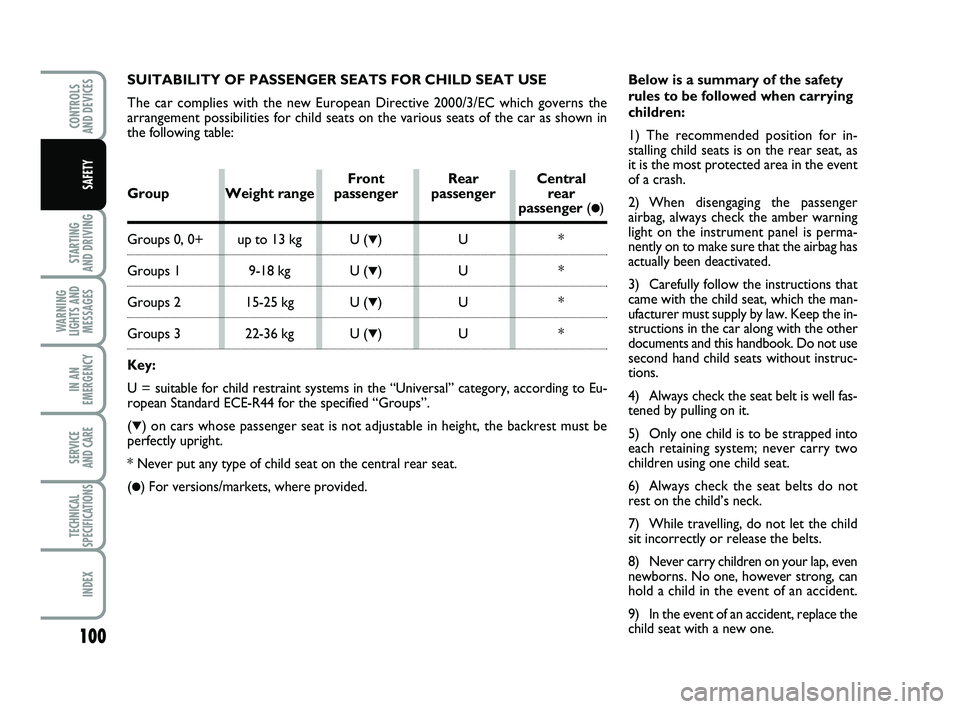
100
STARTING
AND DRIVING
WARNING
LIGHTS AND MESSAGES
IN AN
EMERGENCY
SERVICE
AND CARE
TECHNICAL
SPECIFICATIONS
INDEX
CONTROLS
AND DEVICES
SAFETY
SUITABILITY OF PASSENGER SEATS FOR CHILD SEAT USE
The car complies with the new European Directive 2000/3/EC which governs\
the
arrangement possibilities for child seats on the various seats of the ca\
r as shown in
the following table: Below is a summary of the safety
rules to be followed when carrying
children:
1) The recommended position for in-
stalling child seats is on the rear seat, as
it is the most protected area in the event
of a crash.
2) When disengaging the passenger
airbag, always check the amber warning
light on the instrument panel is perma-
nently on to make sure that the airbag has
actually been deactivated.
3) Carefully follow the instructions that
came with the child seat, which the man-
ufacturer must supply by law. Keep the in-
structions in the car along with the other
documents and this handbook. Do not use
second hand child seats without instruc-
tions.
4) Always check the seat belt is well fas-
tened by pulling on it.
5) Only one child is to be strapped into
each retaining system; never carry two
children using one child seat.
6) Always check the seat belts do not
rest on the child’s neck.
7) While travelling, do not let the child
sit incorrectly or release the belts.
8) Never carry children on your lap, even
newborns. No one, however strong, can
hold a child in the event of an accident.
9) In the event of an accident, replace the
child seat with a new one.
Front Rear Central
Group Weight range passenger passenger rear
passenger (●)
Groups 0, 0+ up to 13 kg U (▼)U *
Groups 1 9-18 kg U (▼)U *
Groups 2 15-25 kg U (▼)U *
Groups 3 22-36 kg U (▼)U *
Key:
U = suitable for child restraint systems in the “Universal” catego\
ry, according to Eu-
ropean Standard ECE-R44 for the specified “Groups”.
(
▼) on cars whose passenger seat is not adjustable in height, the backres\
t must be
perfectly upright.
* Never put any type of child seat on the central rear seat.
(
●) For versions/markets, where provided.
091-110 PUNTO POP 1ed EN 27/03/14 12:02 Pagina 100
Page 105 of 219
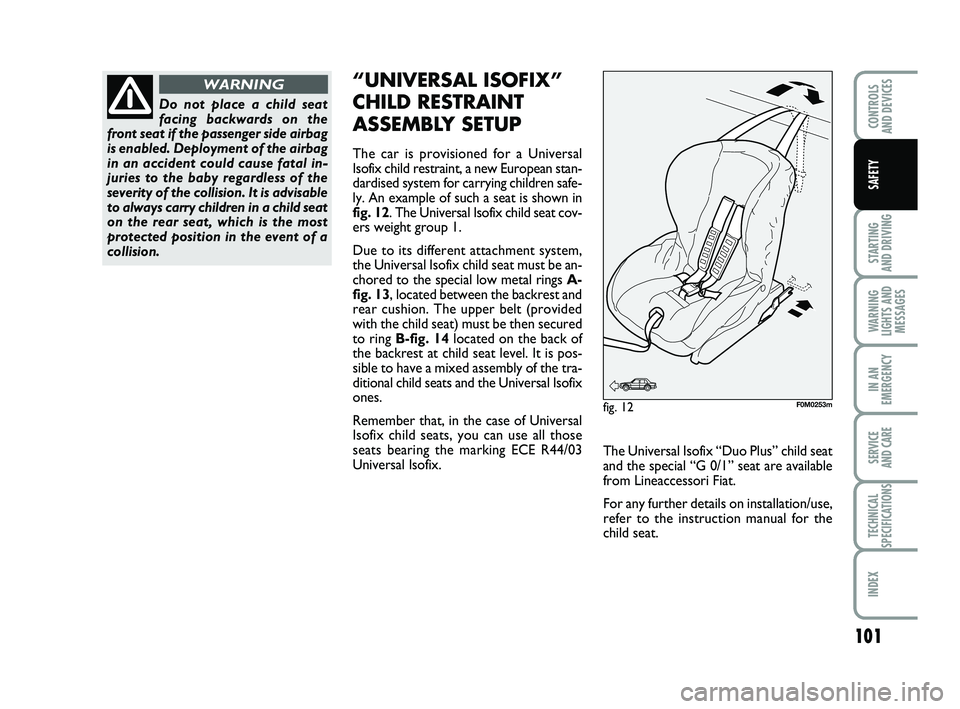
101
STARTING
AND DRIVING
WARNING
LIGHTS AND MESSAGES
IN AN
EMERGENCY
SERVICE
AND CARE
TECHNICAL
SPECIFICATIONS
INDEX
CONTROLS
AND DEVICES
SAFETY
Do not place a child seat
facing backwards on the
front seat if the passenger side airbag
is enabled. Deployment of the airbag
in an accident could cause fatal in-
juries to the baby regardless of the
severity of the collision. It is advisable
to always carry children in a child seat
on the rear seat, which is the most
protected position in the event of a
collision.
WARNING“UNIVERSAL ISOFIX”
CHILD RESTRAINT
ASSEMBLY SETUP
The car is provisioned for a Universal
Isofix child restraint, a new European stan-
dardised system for carrying children safe-
ly. An example of such a seat is shown in
fig. 12. The Universal Isofix child seat cov-
ers weight group 1.
Due to its different attachment system,
the Universal Isofix child seat must be an-
chored to the special low metal rings A-
fig. 13, located between the backrest and
rear cushion. The upper belt (provided
with the child seat) must be then secured
to ring B-fig. 14 located on the back of
the backrest at child seat level. It is pos-
sible to have a mixed assembly of the tra-
ditional child seats and the Universal Isofix
ones.
Remember that, in the case of Universal
Isofix child seats, you can use all those
seats bearing the marking ECE R44/03
Universal Isofix.
fig. 12F0M0253m
The Universal Isofix “Duo Plus” child seat
and the special “G 0/1” seat are available
from Lineaccessori Fiat.
For any further details on installation/use,
refer to the instruction manual for the
child seat.
091-110 PUNTO POP 1ed EN 27/03/14 12:02 Pagina 101
Page 107 of 219
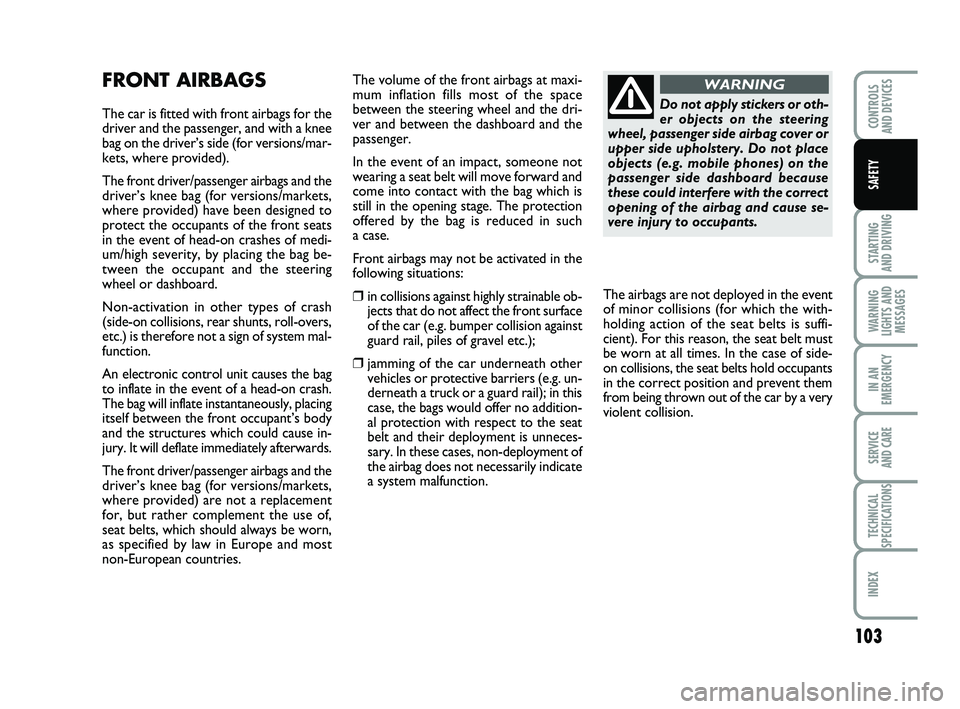
103
STARTING
AND DRIVING
WARNING
LIGHTS AND MESSAGES
IN AN
EMERGENCY
SERVICE
AND CARE
TECHNICAL
SPECIFICATIONS
INDEX
CONTROLS
AND DEVICES
SAFETY
FRONT AIRBAGS
The car is fitted with front airbags for the
driver and the passenger, and with a knee
bag on the driver’s side (for versions/mar -
kets, where provided).
The front driver/passenger airbags and the
driver’s knee bag (for versions/markets,
where provided) have been designed to
protect the occupants of the front seats
in the event of head-on crashes of medi-
um/high severity, by placing the bag be-
tween the occupant and the steering
wheel or dashboard.
Non-activation in other types of crash
(side-on collisions, rear shunts, roll-overs,
etc.) is therefore not a sign of system mal-
function.
An electronic control unit causes the bag
to inflate in the event of a head-on crash.
The bag will inflate instantaneously, placing
itself between the front occupant’s body
and the structures which could cause in-
jury. It will deflate immediately afterwards.
The front driver/passenger airbags and the
driver’s knee bag (for versions/markets,
where provided) are not a replacement
for, but rather complement the use of,
seat belts, which should always be worn,
as specified by law in Europe and most
non-European countries. The volume of the front airbags at maxi-
mum inflation fills most of the space
between the steering wheel and the dri-
ver and between the dashboard and the
passenger.
In the event of an impact, someone not
wearing a seat belt will move forward and
come into contact with the bag which is
still in the opening stage. The protection
offered by the bag is reduced in such
a case.
Front airbags may not be activated in the
following situations:
❒in collisions against highly strainable ob-
jects that do not affect the front surface
of the car (e.g. bumper collision against
guard rail, piles of gravel etc.);
❒jamming of the car underneath othervehicles or protective barriers (e.g. un-
derneath a truck or a guard rail); in this
case, the bags would offer no addition-
al protection with respect to the seat
belt and their deployment is unneces-
sary. In these cases, non-deployment of
the airbag does not necessarily indicate
a system malfunction.
Do not apply stickers or oth-
er objects on the steering
wheel, passenger side airbag cover or
upper side upholstery. Do not place
objects (e.g. mobile phones) on the
passenger side dashboard because
these could interfere with the correct
opening of the airbag and cause se-
vere injury to occupants.
WARNING
The airbags are not deployed in the event
of minor collisions (for which the with-
holding action of the seat belts is suffi-
cient). For this reason, the seat belt must
be worn at all times. In the case of side-
on collisions, the seat belts hold occupants
in the correct position and prevent them
from being thrown out of the car by a very
violent collision.
091-110 PUNTO POP 1ed EN 27/03/14 12:02 Pagina 103
Page 108 of 219
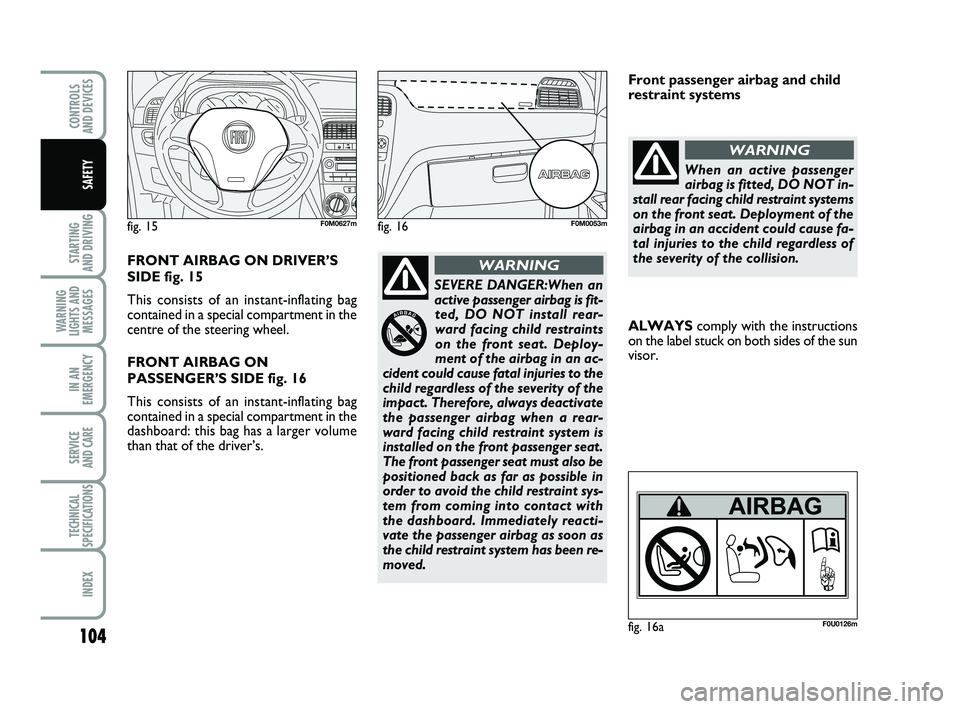
104
STARTING
AND DRIVING
WARNING
LIGHTS AND MESSAGES
IN AN
EMERGENCY
SERVICE
AND CARE
TECHNICAL
SPECIFICATIONS
INDEX
CONTROLS
AND DEVICES
SAFETY
SEVERE DANGER:When an
active passenger airbag is fit- ted, DO NOT install rear-
ward facing child restraints
on the front seat. Deploy-
ment of the airbag in an ac-
cident could cause fatal injuries to the
child regardless of the severity of the
impact. Therefore, always deactivate
the passenger airbag when a rear-
ward facing child restraint system is
installed on the front passenger seat.
The front passenger seat must also be
positioned back as far as possible in
order to avoid the child restraint sys-
tem from coming into contact with
the dashboard. Immediately reacti-
vate the passenger airbag as soon as
the child restraint system has been re-
moved.
WARNING
fig. 15F0M0627mfig. 16F0M0053m
FRONT AIRBAG ON DRIVER’S
SIDE fig. 15
This consists of an instant-inflating bag
contained in a special compartment in the
centre of the steering wheel.
FRONT AIRBAG ON
PASSENGER’S SIDE fig. 16
This consists of an instant-inflating bag
contained in a special compartment in the
dashboard: this bag has a larger volume
than that of the driver’s. ALWAYS
comply with the instructions
on the label stuck on both sides of the sun
visor. Front passenger airbag and child
restraint systems
When an active passenger
airbag is fitted, DO NOT in-
stall rear facing child restraint systems
on the front seat. Deployment of the
airbag in an accident could cause fa-
tal injuries to the child regardless of
the severity of the collision.
WARNING
fig. 16aF0U0126m
091-110 PUNTO POP 1ed EN 03/04/14 14:54 Pagina 104